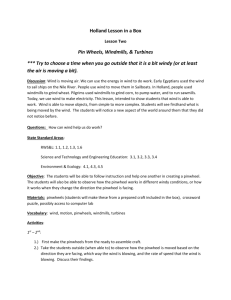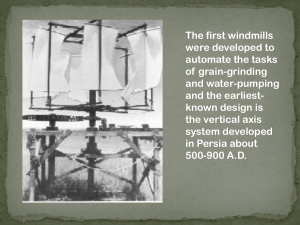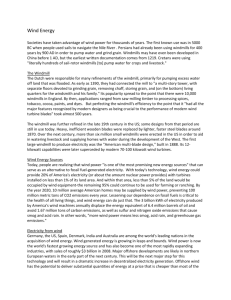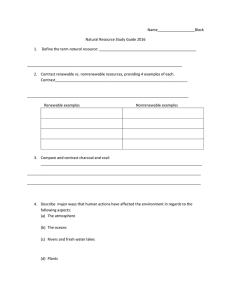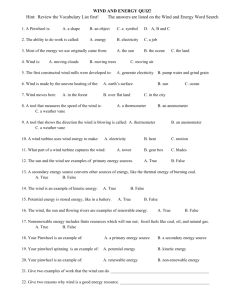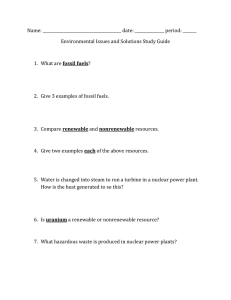Wind Energy - EFMR Monitoring Group
advertisement
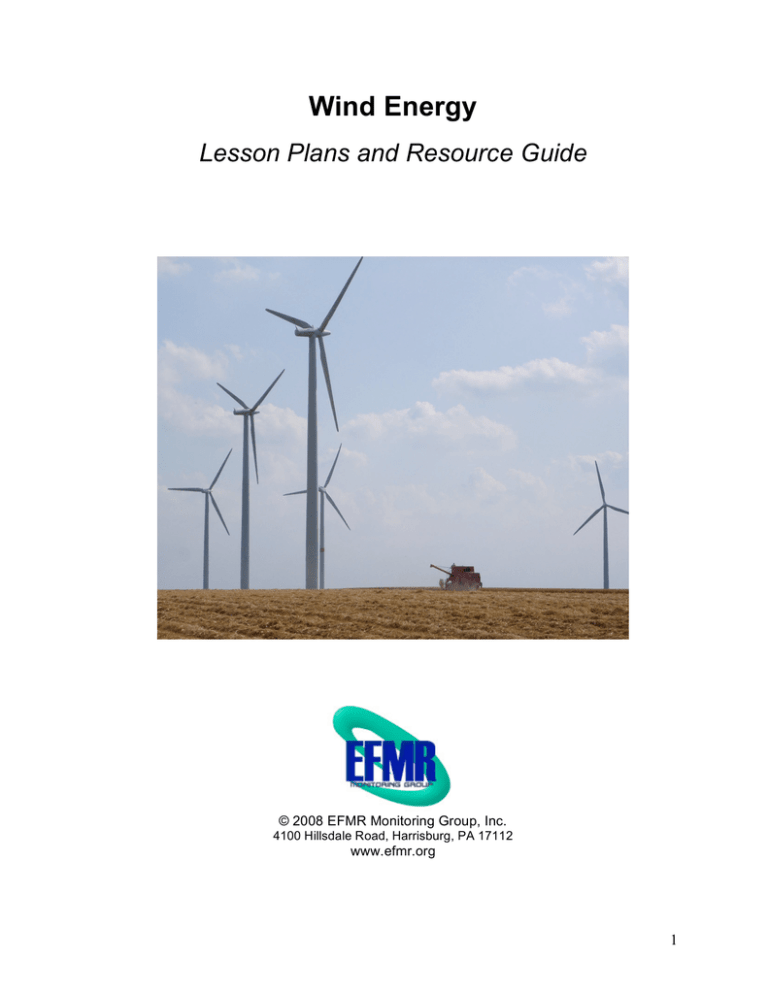
Wind Energy Lesson Plans and Resource Guide © 2008 EFMR Monitoring Group, Inc. 4100 Hillsdale Road, Harrisburg, PA 17112 www.efmr.org 1 Wind Energy Lesson Plans and Resource Guide © 2009 EFMR Monitoring Group, Inc. 4100 Hillsdale Road Harrisburg, PA 17112 www.efmr.org (717)541-1101 Fax (717) 541-5487 Coordinator: Eric Epstein Research and Development: Diane Little Melanie L. Rutkowski Dr. James A. Young William Cologie Janna Match 2 Contents Background Information ………………………………………………..4 Introduction Wind Energy Basics Environmental Impacts Elementary Lesson Plans Activity 1: Introduction to Wind Energy …………………………....5 Activity 2: Recording Wind Intensities ………………………….….6 Activity 3: Wind as an Energy Resource ……………………….….8 Activity 4: Investigating Wind Machines …………………………...9 Activity 5: Comparing Windmills and Wind Turbines …………....10 Middle School Lesson Plans Activity 1: History of Wind Power ………………………………….12 Activity 2: Wind Energy Converted to Mechanical and Electrical Energy ……....13 Activity 3: Comparing Renewable Wind Energy to Nonrenewable Energies …………………………..…..14 Activity 4: Wind Energy Resources in the U.S. …………………..14 High School Lesson Plans Activity 1: Identifying Wind Turbine Construction ………………..16 Activity 2: Debating the Wind Power Industry ……………………18 Activity 3: Wind Power of Foreign Countries ……………………..18 Activity 4: Promoting an Energy Plan for a Community …………19 Activity 5: Keeping Informed of New Technologies and Legislation ………………………………………….…20 Academic Standards…………………………………………………....21 Resources……………………………………………………………..…21 3 Wind Energy Background Information Introduction Wind energy is one of the fastest-growing forms of electric power generation. The search for pollution-free, sustainable energy has promoted this industry worldwide. Additionally, tax incentives for new wind installations in the U.S. have resulted in substantial growth in the industry. This nation ranks first in the world for wind electricity generation. Wind energy accounts for approximately 1% of our electricity supply. Texas leads the U.S. for generating wind energy electric power. Pennsylvania is the leader in the eastern states. The Department of Energy is examining the feasibility of using wind energy to generate 20% of the nation’s electricity by the year 2030. The outlook for increasing the number of wind power plants and wind power technology around the world looks imminent. Wind Energy Basics Wind is caused by the uneven heating of the earth’s surface. Simply, wind can be defined as “moving air.” The wind’s energy has been used to do work throughout history from moving sailboats to generating electricity. Simple windmills, used for hundreds of years, were the primary technology that led to the modern wind turbines of today. The moving blades on a windmill rotate as the wind blows, turning a shaft or rod that can pump or crush something. Windmills of long ago were made to pump water and grind grain into flour. Small windmills were used in the 1920’s to generate electricity in remote locations which did not have electric service. Today, wind is harnessed primarily to generate electricity. The tall towers and large rotating propellers of wind turbines are becoming commonplace. Modern wind turbines, which usually consist of two or three blades, turn according to wind speed. As the blades or wheels rotate, energy is transferred to a shaft or rod to make it spin. The spinning motion drives a generator to produce electricity. The electric power is transported to consumers by way of an electric grid. There are horizontal-axis and vertical-axis wind machines, the most common being the horizontal-axis. Wind machines vary in size. The largest has blades longer than a football field and is 20 stories tall. One this size has the capacity to generate electricity for 1,400 homes. Wind farms, consisting of several to dozens of wind mills, are placed at strategic locations to harvest wind power. Environmental Impacts Wind is a clean and renewable energy resource which has no polluting emissions. The most common environmental concern with wind machines are the effect they have on bird populations. Birds (especially “birds of prey”) and bats are killed when they fly into the rotors. The statistics on the bird mortality rates vary. Better placement of wind power plants has reduced bird mortality rates in some areas. Other concerns of wind power include noise and aesthetic impacts. 4 Wind Energy Elementary Lesson Plans National Science Education Content Standards: B, F PA Academic Standards: 4.2, 4.8 Subject Areas: Science, Language Arts, Social Studies Unit Objectives Students will: 1. Define wind as “moving air” and describe wind characteristics. 2. Compare and identify different wind intensities. 3. Investigate and illustrate wind as a form of energy. 4. Compare wind machines and recognize they all use the wind to do work. 5. Conclude through observations that wind is a clean, renewable energy. Activity 1: Introduction to Wind Energy Objectives Students will describe wind characteristics and define wind as “moving air.” Students will recognize wind as renewable energy and explain it in their own terms. Materials long strips of paper or streamers, simple kite or wind sock, several poster boards, toy shields or umbrellas, chalkboard or large chart paper Procedure Brainstorm and review what children know about wind. Discuss how we know it is windy by looking out a window. Have the students list and discuss all the things that they have seen wind do. Define wind as “moving air.” Take children outside. Have students describe how wind affects all of our senses. (Can you see, feel, taste, smell or hear it?) Pass out streamers and have students observe any signs of blowing wind (moving leaves on trees, hair blowing, flags flapping etc.) Then have students hold up streamers to observe wind movement. Fly a kite or wind sock. Have students describe and share observations. On an obviously windy day, pass out poster boards and shields. Have several children hold the umbrellas and shields (or poster boards) in front of themselves as they run against the wind. Discuss observations. Define wind as “moving air” and a form of energy. Evaluation Have students describe and compare wind observations with drawings and in writing. 5 Activity 2: Recording Wind Intensities (Upper Elementary Grades) Objectives Students will observe and define wind intensity as its power or strength. Students will compare and identify the wind’s intensity according to the Beaufort Scale of Wind Speeds. Materials chart to record observations, fan (with different speeds), “Beaufort Scale of Wind Speeds” optional: weather radio, Internet access ( NOAA Weather Radio: www.weather.gov) Procedure Discuss wind conditions for the day. Demonstrate wind strength or intensity by using a fan. Turn on and move from low to medium to high settings. Introduce the word “intensity.” Allow students to define and determine that wind intensity means the strength or power of the wind. Listen to the local weather forecast (using weather radio, Internet etc.) and have student focus on the wind speed or velocity. Distribute “Beaufort Scale of Wind Speeds” and discuss the different wind speeds or intensities. Have students create their own charts, allowing room for listing wind speeds, (according to the Beaufort Scale), temperatures and general weather conditions for a period of time (2-3 weeks). The charts can be completed at home. They may verify their observations by listening to the weather stations or local weather reports on the internet. Students may include small drawings and notes. Evaluation Students complete charts with descriptions. Enrichment In the classroom, set up a mural or chart divided into different sections by date. Assign pairs of students to write and illustrate simple observations, such as wind velocity, general weather conditions and temperature, for each date. 6 Land Beaufort Scale The Beaufort Scale was originally developed in 1805 by Sir Francis Beaufort. It is a system for estimating wind strengths without the use of instruments. It is currently still in use for this same purpose as well as to tie together various components of weather (wind strength, sea state, observable effects) into a unified picture. Force Speed knots mph 0 Land Conditions Calm, smoke rises vertically 1 1-3 1-3 Light air, direction of wind shown by smoke drift only 2 4-6 4-7 Light breeze, wind felt on face, leaves rustle, vanes moved by wind 3 7-10 8-12 Gentle breeze, leaves and small twigs in constant motion, wind extends light flag 4 11-16 1318 Moderate breeze, raises dust, loose paper, small branches move 5 17-21 1924 Fresh breeze, small trees in leaf begin to sway 6 22-27 2531 Strong breeze, large branches in motion, umbrellas used with difficulty 7 28-33 3238 Near gale, whole trees in motion, inconvenience felt walking against the wind 8 34-40 3946 Gale, breaks twigs off trees, impedes progress 9 41-47 4754 Strong gale, slight structural damage occurs 10 48-55 5563 Storm, trees uprooted, considerable damage occurs 11 56-63 6473 Violent storm, widespread damage 12 64+ 74+ Hurricane, extreme destruction NOAA Satellite and Information Service http://www.ncdc.noaa.gov/ol/climate/conversion/beaufortland.html 7 Activity 3: Wind as an Energy Resource Objectives Students will recognize and demonstrate wind as a form of energy. Students will determine that the wind is a “renewable” resource. Materials lightweight paper, fan, magazine and Internet pictures illustrating wind power, 1 or 2 poster boards, pieces of coal in clear cup, picture illustrating a windy day Procedure A. Explain that wind is a kind of energy that can be used to do work. Define “work” as using a force to move something over a distance. Examples are moving sailboats, turning windmills and flying kites. Distribute lightweight paper and direct students to create something that will move by the wind’s force. Remind them that they should create something that captures the wind’s energy. Take students outside (if it’s breezy) or use a fan to have them demonstrate their wind toy. Compare and discuss why some move more than others. (Some capture more of the wind’s energy.) Review wind as a form of energy. B. Introduce wind as renewable energy: Show the students a clear cup filled with pieces of coal and a picture illustrating a windy day. Discuss both coal and wind as being energy resources. Ask them which can be completely used up and which one will always be in plentiful supply. Review that fact that wind is an energy that cannot be exhausted. It’s “renewable” which means the supply is always available. Review wind as “moving air” and a “renewable” energy resource. Encourage students to explain wind energy and define the term “renewable” in their own terms Evaluation A. Students may explain why the wind is a form of energy (because it can be used to do work) and draw examples of how it can be put to work. B. Students may be quizzed on the term, “renewable.” Enrichment Have students find pictures illustrating wind “doing work.” Create a classroom collage or photo gallery entitled “Wind Doing Work.” Have students share pictures and explanations. Have students add their examples on poster display. 8 Activity 4: Investigating Wind Machines Objective Students will determine that windmills use wind energy to do work. Materials windmill pictures, simple pinwheel, construction paper, pins or long tacks, straws, safety straight pins, pencils, cardboard, clay, fan, computer with Internet access (optional) Procedure Review wind as an energy resource and how man has utilized it. Display pinwheel and have students explain how it works. Introduce the windmill with pictures and have students explain how it looks and works like a pinwheel. (See “Background Information.”) Explain how windmills were often used to crush grains and pump water. Have students make a pinwheel as a comparison to a windmill. Pinwheel: Cut construction paper into a square (8 ½ inches or 20 cm.) Draw straight lines from the 4 corners to the center. Cut from outer corners along lines to ½ inch or 1.5cm. of center point. Bring each corner to center gently without folding and glue. Push pin through center of paper and eraser at top of pencil. Secure bottom of pencil in clay mounted on cardboard. Have students demonstrate their pinwheels and compare to windmills. Ask if any fumes or pollution are given off from windmills and introduce the term “clean energy.” Have students define the term and discuss other forms of energy that may pollute or give off smoke and fumes. Review the term “renewable” energy. Evaluation Students are quizzed on how machines use the wind to do work and define the term “clean and renewable” energy. Enrichment Have students construct an anemometer (an instrument that measures wind speed). 9 Activity 5: Comparing Windmills and Wind Turbines Objectives Students will compare windmills to wind turbines. Students will determine that wind turbines use the wind’s energy to generate electricity. Materials pinwheel, pictures of windmills and wind turbines, diagram of wind turbine (attached), writing/drawing paper Procedure Review how a windmill works like a pinwheel. Introduce a wind turbine with pictures and have students make comparisons. Explain that a wind turbine is a modern version of a windmill. Both machines have propeller-like blades that are mounted on tall towers. The blades catch the wind’s energy (kinetic). This energy can be changed into mechanical energy that is used for crushing mill or pumping water, typical of a windmill. Wind energy can also be changed into electrical energy. Demonstrate wind energy being converted to mechanical energy: Tie a string to the rotating tip (or fixed rod inside wheel) of a pinwheel. Tie the other end to a small lightweight toy. Have fan blow on pinwheel or go outdoors (if windy). The string will circle the rotating rod inside the wheel to lift the toy. The pinwheel lifting a small object demonstrates mechanical energy. Explain that the rotating part on a wind turbine is connected to a devise called a generator which makes electricity. Show basic diagram of wind turbine. Ask if any pollution (fumes or smoke) seems to come from wind machines. Read “Environmental Impacts” in Background Information. Discuss wind as an energy resource for the future. Take students to library to research windmills and wind turbines. The research may be teacher-directed for lower grade levels. Evaluation Have students compare a windmill and a wind turbine with diagrams and basic explanations or reports depending on grade level. Enrichment Students make a model or diorama of a windmill or wind turbine and present to class. Upper grades may complete Middle School Lesson #2. 10 Need Project www.need.org 11 Middle School Lesson Plans National Science Education Content Standards: B, E, F PA Academic Standards: 4.2, 4.8 Subject Areas: Science, Social Studies, History, Language Arts Unit Objectives Students will: 1. Research and identify developments in the history of wind power. 2. Compare windmills and wind turbines. 3. Explain and illustrate how a turbine uses wind energy to generate electricity. 4. Compare renewable wind energy to a nonrenewable energy. Activity 1: Research History of Wind Power Objective Students will use the internet to research the history of wind power. Materials Internet access: www.eere.energy.gov www.awea.org www.eia.doe.gov/kids/history/timelines/wind.html (timeline of wind power) research books, optional: pinwheel, string, small plastic toy (car), fan Wind Power History 500 AD Persia (Iran) began using windmills 1300 Western Europe used horizontal-axis type windmills 1850s Windmill production developed in the American West 1900s-early Windmills used to pump saltwater to evaporate ponds in California. 1950s Most windmill companies failed economically in the US. 1973 Wind energy interest increased as oil prices rose. (Due to OPEC) 2006 Wind power accounted for 5% of renewable energy in U.S. 2007 U.S. total wind power generating capacity increased by 45% in 1 year. 2008 AWEA estimates U.S. wind farms will generate 48 billion kWh of wind energy which is the equivalent of powering over 4.5 million homes. PA’s wind industry generates over 300 megawatts of wind power, enough to power over 90,000 homes. More installations are planned. The early windmills were used to grind grain and irrigate crops. They were constructed horizontally (the wheels being horizontal to the ground). These types of windmills were not as efficient as the vertical ones developed primarily in the 20th century. Windmills were especially useful in Denmark because of the nearly constant (300 days per year) winds blowing off the Jutland. 12 Procedure Distribute copies of “Wind Power Timeline” (or view on classroom monitor) from websites listed above. Introduce history of wind power beginning with early sailboats and the use of windmills. Have students discuss points of interest and list on board. Group students together, according to interests. Assign research and a presentation project depicting a time period or development in wind power history. Evaluation Student groups may give class presentations on a specific time period in wind power history. Encourage use of visual aids. Activity 2: Wind Energy Converted to Mechanical and Electrical Energy Objectives Students will compare windmills and wind turbines Students will diagram and identify the basic parts of a wind turbine and explain how they work. Materials string, pinwheel, pictures of windmills and wind turbines, lightweight object (that can be wrapped with string) Procedure Display pictures of windmills and wind turbines. Have students identify each and compare. Explain that windmills commonly generate mechanical energy such as crushing grain while wind turbines generate electrical energy. Demonstrate wind energy being converted to mechanical energy: Tie a string to the rotating tip (or fixed rod inside wheel) of a pinwheel. Tie the other end to a small lightweight toy. Have fan blow on pinwheel or go outdoors (if windy). The string will circle the rotating rod inside the wheel to lift the toy. The pinwheel lifting a small object demonstrates mechanical energy. Show or distribute diagrams of a wind turbine and explain how it converts wind power into electrical energy. (A wind turbine has a shaft that is connected to a generator which changes the mechanical energy into electrical energy.) Show basic diagram of wind turbine and discuss. Evaluation Have students briefly explain how a wind turbine works and draw diagrams with the basic parts: foundation, tower, nacelle and rotor. 13 Activity 3: Comparing Renewable Wind Energy to Nonrenewable Energies Objective Students will recognize wind as a renewable energy and compare it to a nonrenewable energy. Materials 2-3 poster boards or chart papers, internet access Procedure Review and have students define “renewable” and “nonrenewable energy”: Renewable energy is inexhaustible and is generated from natural resources such as wind, sunlight, running water and geothermal heat. Nonrenewable energy resources are limited in supply and are primarily fossils fuels which include petroleum, natural gas and coal. Uranium is a nonrenewable energy resource used in nuclear power plants. Discuss and list several advantages and disadvantages of renewable wind energy. (See “Background Information.”) Divide class into 4 groups and have each group research and compare wind energy to a nonrenewable energy: coal, nuclear, petroleum or natural gas. (Class time and homework may take a week.) The groups can list their comparisons with brief descriptions and data on a chart with 2 columns. Rows can be labeled: economics, environmental issues, physical location issues, politics and other points. Have each group present their findings to the class and display charts in classroom. Review and have student evaluate the overall data. Evaluation Student groups complete research and give oral presentations. (Individual responsibilities within each group can be listed and given to teacher.) Enrichment Visit a wind power plant. Invite a guest speaker to class who is involved with the wind energy industry. Activity 4: Wind Energy Resources in the U.S. Objective Students will identify wind energy resources in the U.S. Materials Internet access: www.windpoweringamerica.gov/wind_maps.asp (U.S. Wind Energy Resource Map) www.pawindmap.org (Pennsylvania Wind Map) www.pennfuture.org 14 state maps, almanacs, chamber of commerce for specific location Procedure Explain that wind speed is an essential criteria for wind power plants: Annual wind speeds need to be at least 13 miles per hour. Stronger winds generate more power. Generally, wind speed increases with higher altitudes in open spaces. Texas and California are the greatest producers of wind energy production in the United States. Pennsylvania has the greatest wind energy production of the eastern states. Copy and distribute windmaps of the U.S. www.windpoweringamerica.gov/wind_maps.asp Instruct students to locate wind farms in different states and to determine which states have the most and least. Discuss average wind speeds. Ask what may prevent the development of wind electric power generation in a state even if the wind speeds are sufficient. As a group or independently, have students explore different wind energy websites in different sections of the country. www.windenenergy.com (Southwest) www.iowawind.org (Iowa) www.wintecenergy.com (California) www.infinitepower.org (Texas) Have students compare and contrast the wind power installations in these states with Pennsylvania’s installations. They should include information on average wind speeds. Evaluation Students compare the wind electric power generation of two states in a creative project. Enrichment Students may research current legislative proposals related to wind energy production and report to class. 15 High School and Advanced Lesson Plans National Science Education Content Standards: D, E, F PA Academic Standards: 4.2, 4.8 Subject Areas Science, Social Studies, Language Arts, Civics Unit Objectives 1. Students will demonstrate an understanding of wind turbines, their construction and how they work. 2. Students will evaluate energy ideas for a community and communicate their findings. 3. Students will use a variety of resources to gather current information on wind energy technology and legislation. Activity 1: Identifying Wind Turbine Construction Material diagram of wind turbine, Internet access, research books and web sites Procedure Review the use of wind turbines to collect the wind’s kinetic energy and convert it into electrical energy. Wind turns the propeller blades, which spins a shaft that drives a generator to produce electricity. Distribute copies of the wind turbine diagram: www.eere.energy.gov/de/wind_power.html Discuss and/or research parts of the turbine and their functions: tower, rotor, brake, nacelle, generator, controller, wind vane, low and high speed shafts and anemometer. Explain the basic workings of the wind turbine. Have students research variations in types (horizontal and vertical), size and electrical energy output. Students may then draw or create a model of a single turbine and label the parts and dimensions. They should illustrate relative size by comparisons to common manmade or natural structures. Evaluation Students complete turbine diagram or model with parts and dimensions labeled. Have students make drawings of modern wind farms for the future. 16 Wind Turbine Wind Turbine Components U.S. Department of Energy www.energy.gov www.eere.energy.gov/de/wind_power.html 17 Activity 2: Debating the Wind Power Industry Objective Students will research, evaluate and debate the use of wind power as an industry. Materials computer with internet access, “Background Information”, website resources Procedure Review the nature of renewable and nonrenewable energy sources. (See “Background Information.”) Students should classify wind power as a clean, sustainable (renewable) energy resource. Discuss advantages and disadvantages of wind-powered energy. Ask what possible obstacles there would be to the widespread development of wind energy. Have students recall their research on turbine construction. Divide students into groups to research and compare the advantages and disadvantages of wind-powered energy production. They should use a balanced variety of sources to collect information on the wind power industry including: economics, energy independence, physical constraints, environmental and political issues, etc. Encourage students to search websites that are neutral, as well as biased, for both sides. Have groups share findings with class. Students may choose to be advocates or opponents of the industry and prepare for a debate. Evaluation Students complete research and debate the wind power industry. Activity 3: Wind Power of Foreign Countries Materials Internet access, “Resource Guide”, current periodicals, world almanacs Objective Students will research and report on the development of the wind power industry in foreign countries. Procedure Discuss the global wind power industry. Have students independently choose a country to research. Countries may include: Denmark Great Britain The Netherlands Germany China 18 Australia Statistics on energy consumption and production should be included. General climate information, wind speeds, geographics and economics should be reported. Evaluation Students complete reports with maps of specific country and current wind power development. Have students compare and contrast the wind power programs in these countries with those in the U.S. (and Pennsylvania). Activity 4: Promoting an Energy Plan for a Community Objective Students will research, evaluate and communicate the case for development of a wind power plant in their state. Materials computer with Internet access, additional research materials on wind power, maps of the designated community (including topographic), information available on specific location Procedure Discuss the case for building and maintaining a wind farm for a community in their state. (In Pennsylvania, an underdeveloped community in the northeast part of the state may be suggested.) First, students should determine the community’s main energy source and alternate sources: coal, nuclear, petroleum, natural gas, geothermal, hydroelectric and wind. (Identify the current renewable and nonrenewable energy production.) Then relate the feasibility of constructing a wind power plant. Students should address problems that may arise concerning: site construction issues, economics, environmental issues and political issues. Have students present their case in a report and/or letter form and include a map designating the proposed site for construction of the wind power plant. Evaluation Students complete research and substantiate their case for the construction of a wind power plant in a specific location. Enrichment Students communicate their findings to the public, their legislator or state department in written form. 19 Activity 5: Keeping Informed of New Technologies and Legislation Objectives Students will use a variety of resources to become informed regarding new technologies and legislation. Materials Internet access, newspapers, magazines, websites: www.dep.state.pa.us Pennsylvania Department of Environmental Protection www.puc.paonline.com Pennsylvania Public Utilities Commission www.pawindenergynow.org Pennsylvania Wind Working Group www.energy.gov United States Department of Energy Procedure A. Discuss ways of finding up-to-date information regarding wind energy technology, laws and current legislative proposals. (See websites.) Additional information may be obtained through the local state representative and senator. Compile a list of contacts. Have students list recently enacted laws and current legislative proposals regarding renewable energy, primarily wind. Assign weekly news reports that students will briefly list on a progressive classroom chart. Review and discuss updates to chart bi-weekly. B. Motivated students may choose to pursue further and communicate personal opinions by contacting their local state representative or senator, U.S. senators or congress person to voice their opinions. Evaluation Students research current information and list on chart. Enrichment Students may attend public meetings, contact political officials or write an editorial for a newspaper to communicate personal opinions. 20 Academic Standards PA Academic Standards for Science and Technology: Physical Science, Chemistry and Physics Science, Technology and Human Endeavors 3.4 3.8 PA Academic Standards for Environment and Ecology: Renewable and Nonrenewable Resources 4.2 www.pde.state.pa.us National Science Education Content Standards: Physical Science Science and Technology Science in Personal and Social Perspectives B E F www.nsta.org/publications/nses.aspx Resources Books Gipe, Paul. Wind Power: Renewable Energy for Home, Farm and Business. Vermont: Chelsea Green Publishing, 2004. (middle-high school) Woelfe, Gretchen. The Wind at Work. New York: HarperCollins Publishers, 2000. (elementary) Websites Alliance to save Energy www.ase.org American Wind Energy Association www.awea.org Energy Information Administration www.eia.doe.gov Kidwind Project: Teacher Resources www.kidwind.org Pennsylvania Department of Environmental Protection www.dep.state.pa.us 21 Pennsylvania Public Utilities Commission: Alternative Energy www.puc.paonline.com Pennsylvania Wind Map www.pawwindmap.org Pennsylvania Wind working Group www.pawindenergynow.org National Wind Technology Center www.nrel.gov/wind U. S. Department of Energy www.energy.gov Windustry www.windustry.org © 2009 EFMR Monitoring Group, Inc. 4100 Hillsdale Road Harrisburg, PA 17112 www.efmr.org (717)541-1101 Fax (717) 541-5487 Coordinator: Eric Epstein Research and Development: Diane Little Melanie L. Rutkowski Dr. James A.Young William Cologie Janna Match 22
